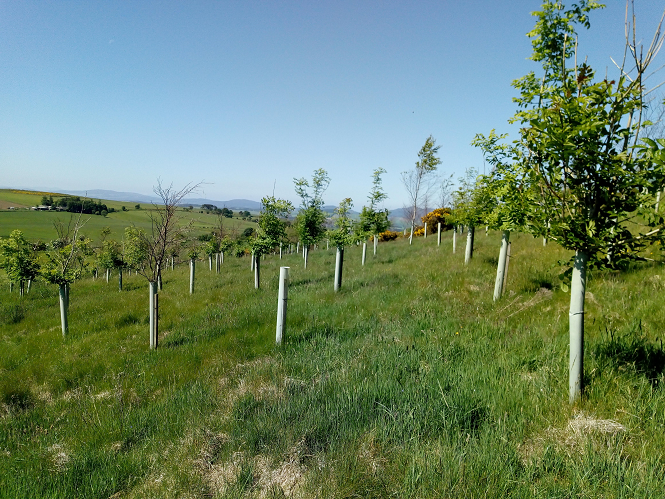Growing trees and your business at the same time
7 February 2022Woodlands integrated into farm businesses can offer considerable benefits without compromising food production and farm business viability.
Last year, smaller woodland owners, farmers and crofters accounted for almost 200 of the 320 woodland creation schemes approved under the Forestry Grants Scheme (FGS). In Central Scotland, the average size of a new woodland was around 25 hectares.
The integration of woodlands into existing businesses is very much part of the woodland creation picture in Scotland and one that is being actively promoted and encouraged by Scottish Forestry.
The Forestry Grants Scheme
Under the FGS, farmers can receive grants of up to £6,210 per hectare towards the costs of new woodland planting, with money for fencing and tree protection available on top of this.
Farmers within the Central Scotland Green Network (CSGN) area can also get a special contribution of up to £2,500 per hectare.
The FGS is a competitive scheme and open to applications all year round and you are still eligible for the Basic Payment Scheme. The forestry grants will remain open for applications in its present form until at least 2024.
Further information at https://www.ruralpayments.org/publicsite/futures/topics/all-schemes/forestry-grant-scheme/
Case Study
Greens Farm in Dunsyre.
A farm of 380 ha, 90 ha’s of woodland have been planted in the last 20 years. Around 21 ha of productive woodland was planted recently with FGS support. Approval has been given for a further 20 ha of conifers to be planted this winter.
The farmer’s objective was to grow trees to diversify potential income streams. The planting has been undertaken on poorer hill and in bye field areas. Here, the new woodland will help rationalise the farm’s fencing in the short term and in time will provide a good tax-free income when felled.
Native woodland planting has been undertaken to fence off and manage riparian margins, whilst improving the ecological diversity of the farm within the wildlife corridors created.
The recent woodland creation received CSGN payments of an additional £2500/ha. These additional payments provided a strong incentive to follow the afforestation route on some of the poorer farmland.
More help and guidance to farmers
Free Farm Woodland Assessments
In the Central Scotland Green Network area, Scottish Forestry provides FREE assessments to help identify the opportunities for integrating farms into existing farm businesses.
https://forestry.gov.scot/support-regulations/farm-woodlands/get-help-to-plant-trees
Integrated Trees Network
This is demonstrator network of farms, crofts and estates which host events, providing information and support for other farmers and crofters who are considering planting trees. It is supported by Scottish Forestry and the Scottish Government.
More funding opportunities
The Woodland Carbon code: a potential opportunity to get more income from your woodland by selling carbon credits locked up in new woodlands.
https://www.woodlandcarboncode.org.uk/
The Woodland Trust Offers a wide range of support and free advice, including grants for planting new native woodlands.
https://www.woodlandtrust.org.uk/plant-trees/large-scale-planting/morewoods/
Future Woodlands Scotland Fund
An incentive based approach aimed at supporting land managers wishing to plant native woodlands of 3Ha upward.
https://www.futurewoodlands.org.uk/new-2m-fund-launched-to-boost-scottish-native-woodlands/
Contact: For regional Scottish Forestry Contacts, go to their website
Sign up to the FAS newsletter
Receive updates on news, events and publications from Scotland’s Farm Advisory Service

